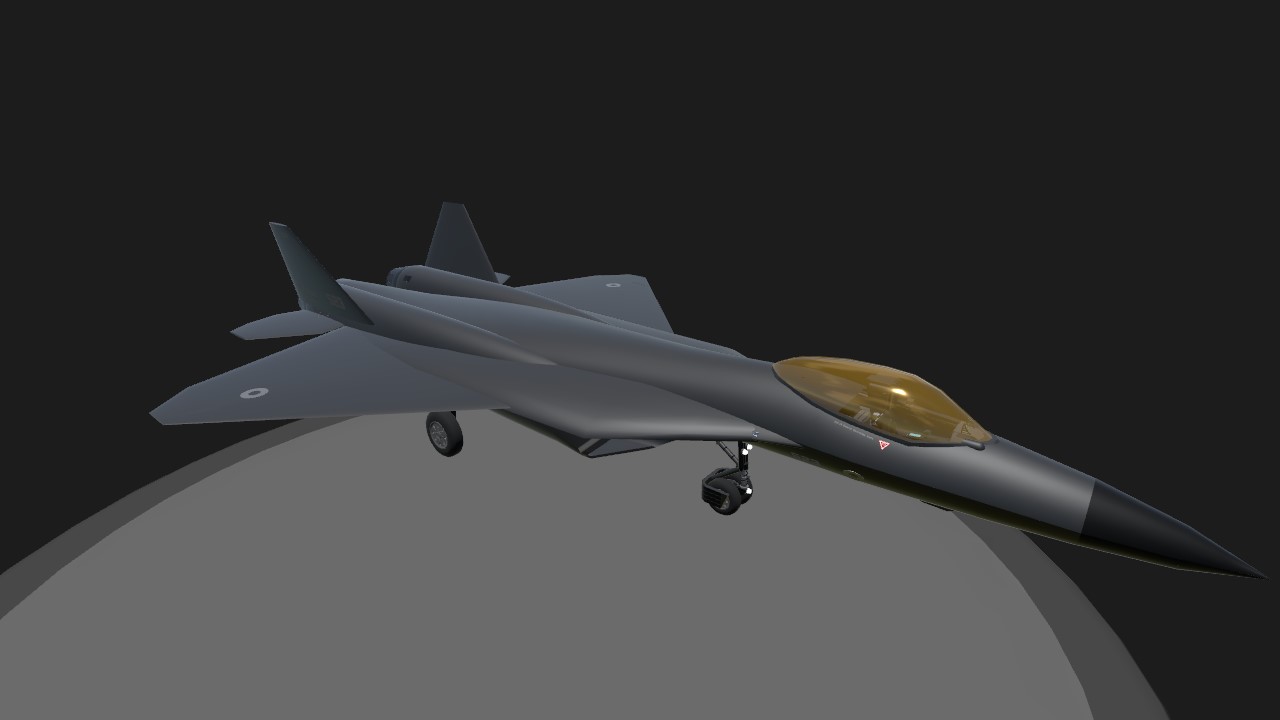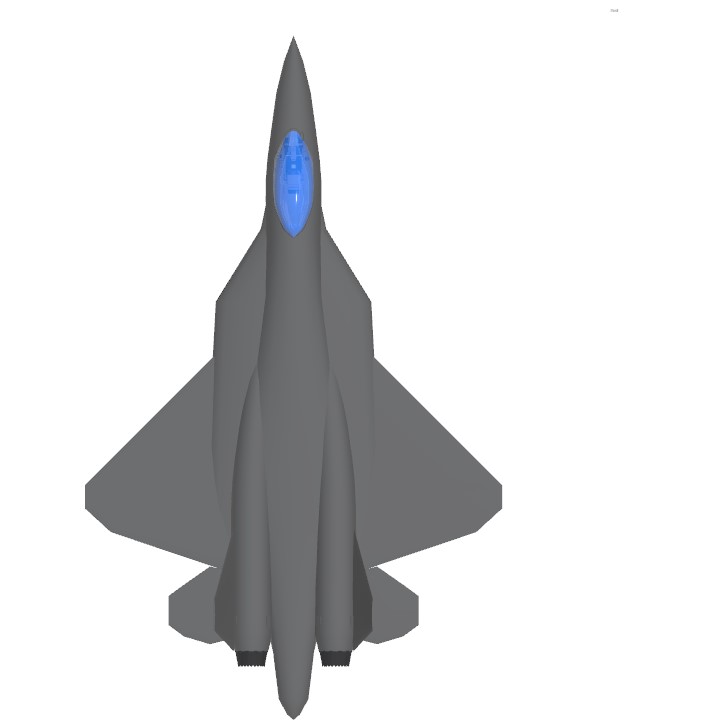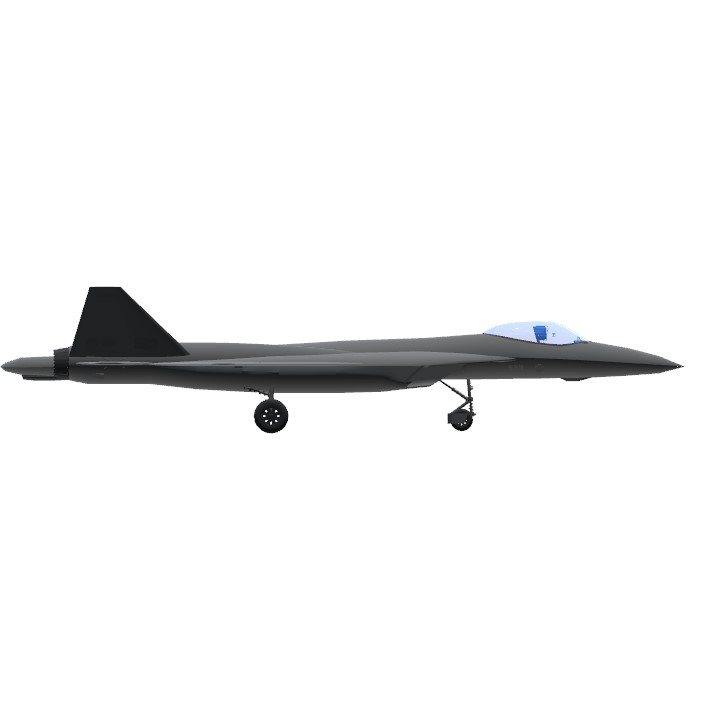BAE Talon FGA.70/A2
Advanced 5th Generation Stealth Multirole Fighter
General Specifications
- Crew: 1
- Length: 57ft
- Wingspan: 44ft
- Height: 12ft
- Wing Area: 450ft^2
- Empty Weight: 35,000lb
- Gross Weight: 39,000lb
- Max Takeoff Weight: 75,000lb
- Powerplant: 2x Saturn AL-60F2 afterburning turbofan
20,200lb thrust dry,
32,200lb thrust wet,
33,500lb thrust emergency power
Performance:
- Top Speed: Mach 2.4
- Cruise Speed: Mach 1.4
- Range: 2500km (A2A refueling possible)
4000km with external tanks
- Service Ceiling: 64,000ft
- G limits: +9/-4
- Wing Loading: 86lb/sqft
- Thrust to Weight: 1.25
Avionics:
- BAE/RS-55 AESA radar
- BAE/EW-5 Advanced EWS
- BAE/DS-7 DAS sensor system
- BAE/EOT Electo-Optical Targeting System
- BAE/ANS-44 CNI system
- BAE Dragon IRST
- BAE AGPWS
All sensors and systems are designed with intercommunication to give the pilot a cohesive view of the local battlespace. The BAE/EW-5 system is capable of detecting and jamming enemy radar systems.
Capabilities:
The aircraft features an extremely low frontal RCS, equivalent to a golf ball, which is achieved through the stealthy design, advanced inlets and S-ducts, and ceramic based composite RAM coating on the entire aircraft. A modular software system is enabled, with nations being able to include their own systems to ensure compatibility with native communication and datalink systems. The aircraft is able to receive information from other allied aircraft in the area and radar information is shared across all linked aircraft, which allows the pilot a more comprehensive view of the combat zone. The aircraft is fitted with an internal weapons bay able to carry 6 R-111 Venom II missiles, or various AGMs and free fall munitions. Both air to air and air to ground missions are possible, with the Talon able to excel at both roles.
Cockpit:
The aircraft features a fully glass cockpit, with 2 main MFDs, one smaller display between the pilot's legs and various other displays on the side panels. Both a HUD and HMD are present, with the HUD being retractable when the HMD is in use for short range radar locks.
HOTAS controls are present, with throttle and stick on either side of the pilot. All major flight functions are accessible via buttons on the controls. The MFDs are able to display different information, selectable via a switch on the throttle.
The pilot is seated in a Martin-Baker US18 T-X ejector seat, the latest seat to be developed by Martin-Baker.
The following content is from Multiverse Worldbuilders, a SPRP
History:
The FGA.70 began life as a prototype aircraft developed in the New Soviet Union by Sukhoi to replace the poorly performing Su-67. Designated the T-70, several prototypes were made and the aircraft showed promising performance. However, by this time the NSU was on its last legs and economic decline coupled with political turmoil ensured the aircraft never left prototype stage. Eventually the NSU collapsed into the Second Soviet Civil War, with hardline communists aiming to rebuild the nation. In the chaos, the Sukhoi engineers leading the T-70 program stole blueprints and technical information and defected to the Great British Republic, an ally state. The engineers took the T-70 blueprints to BAE, and the FGA.70 was born.
The British variant featured numerous modifications, including Rolls-Royce Neptune EL-70SM afterburning turbofans which far outperformed the original Soviet aircraft in efficiency and ease of maintenance, as well as completely overhauled avionics systems. British engineers also reworked the airframe to fix several glaring RCS issues.
The aircraft was introduced to RAF service to replace the expensive Eurofighter Typhoon and complement the F-35As which had been recently purchased.
The Talon was also exported to the Iberian Republic, a long standing British ally, and was loved by Iberian pilots.
The FGA.70s trial in air combat was during the Saltwater-Italian war, where the GBR deployed a task force to assist Saltwater. The Talon came up against experienced Italian pilots flying F-35s and suffered 2 losses for no kills. Following this disappointing performance, the Talon faced off against China after a British ship lost power and drifted into Chinese waters. In the ensuing conflict, 3 Chinese J-28 fighters were shot down for the loss of 1 Talon. Following this, the most recent conflict involving the Talon was a raid on a Panamanian nuclear missile silo, in which British Talons engaged Russian Su-57 Felon 5th generation fighters. This was a historic battle as the Talon faced it's Sukhoi cousin. At the end of the conflict, 4 Felons were shot down for the loss of 2 Talons to SAMs.
The Talon's ground attack record is more illustrious, with the two previously mentioned Talons being the only aircraft downed by ground fire. Iberian pilots operating FGN.70 Sea Talons decimated Svalbardian ground forces prior to a ground invasion and ensured minimal casualties for Iberian ground forces. Additionally, British Talons wreaked havoc in the British intervention in West India, where the GBR and her allies engaged hostile forces locked in a brutal conflict. FGA.70s with JDAMs slashed through enemy ground forces and airbases, rendering Pakistan out of the conflict in a matter of weeks. Additionally, Talons operated alongside MQ-9 Reaper UCAVs to eliminate the tyrannical Cameroon dictator, with the Talons dropping JDAMs on the Cameroon government building while drones used hellfire missiles to kill the dictator as he left his house in the morning. By far the most bizarre operation involving the FGA.70 was the defence of the Akoyan Federation. A small cult nation in North America called the Lost Causes Republic declared a war of liberation to free the American continent from the "evil influences" of the other North American nations. The tyrannical nation set it's sights on the Akoyan Federation first, which contained a large British force sent to assist Akoya in a planned invasion of a different hostile state to the south. A large Lost Causes Republic force entered Akoya from the South, being comprised entirely of ancient Second World War era equipment. The British forces moved to meet them and counter their advance, and in the ensuing battle tens of thousands of radicalised LCR soldiers carried out suicide charges on British positions. FGA.70s were ordered to assault a massive force of 30,000 LCR infantry moving towards the main British force, and dropped hundreds of JDAMs and cluster munitions. The entire LCR force of 80,000 soldiers was eliminated for the loss of only 200 British soldiers, a K/D ratio of 400:1. FGA.70s eliminated at least 30,000 soldiers via airstrikes and this remains the most successful A/G mission in history.
Note: The described Lost Causes Republic conflict really did happen on SPMW, after an inexperienced RPer joined the server and attempted to invade his neighbour, Akoya.
Controls:
Regular flight controls
AG1 for opening canopy
AG7 for afterburner
AG8 for landing lights
Credits:
@QuitePossiblyMangled
For help with the air inlets, as well as general guidance throughout the whole build.
@ThatCanadian
For helping to build the cockpit interior and detailing the instrument panel, as well as some small additions such as sensors and fixing the IRST
Specifications
General Characteristics
- Predecessor [Worldbuilding] FGA.70
- Created On Windows
- Wingspan 43.5ft (13.3m)
- Length 56.9ft (17.3m)
- Height 11.6ft (3.5m)
- Empty Weight N/A
- Loaded Weight 28,460lbs (12,909kg)
Performance
- Power/Weight Ratio 18.951
- Wing Loading 46.2lbs/ft2 (225.6kg/m2)
- Wing Area 616.0ft2 (57.2m2)
- Drag Points 7574
Parts
- Number of Parts 392
- Control Surfaces 10
- Performance Cost 1,894




